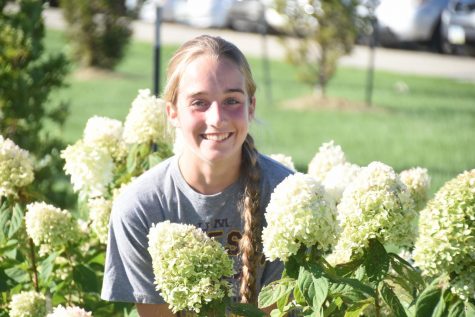Glassy Skies
The courtyards pose a severe threat to the bird population .
Robin eggs hide under a porch.
February 19, 2020
The courtyards are meant to be a place where students can enjoy nature. Their large windows let light into the building and allow students to see the outside world, but also result in the deaths of unsuspecting birds. The expansive, reflective surface of the glass tricks birds into thinking that the window is a patch of sky they can fly into.
The global architecture and design firm Perkins+Will was in charge of constructing the high school. In an interview with School Construction News, design principal, Jerry Johnson described the courtyards as, “providing safe, secure and contained access to the outdoors.” While students may be safe from the adult passerby, going out into the courtyard means seeing birds stricken motionless, lying upturned on the cold cement.
A few students have even witnessed their deaths. “I was in B lunch and there was this one bird sitting on a tree. Then, it tried to go up and out of the courtyard, and it just kept hitting the windows because it was confused. This was the lunch courtyard too, so people were eating outside. At one point it hit the window so hard that it just fell and wouldn’t get back up,” Mckenna Straley 20’ said.
According to The Migratory Bird Program, collision with building glass is the leading cause of bird death, killing an estimated average of 599,000,000 birds per year. This staggering affinity for running into glass is probably where the term “bird brain” came from. However, a study conducted by the Hobart and Williams Smith Colleges suggests that birds accustomed to running into buildings in urban areas may eventually learn to avoid windows. As a result, large buildings in rural areas pose a larger threat than similar buildings in urban areas. Zach Choteau, a reporter for School Construction News, said “Johnston High School is a 369,000 square feet facility situated on what once was 125 acres of corn field.” The staggering size combined with the expansive corn fields flags Johnston High School especially hazardous.
While the framework and location of the building itself cannot be changed, there are a few solutions that could be put into place. As long as the birds can see a surface behind the glass they will not run into it. Large blinds set on timers have been added to most major windows to help deter the birds. However, the blinds often remain open so that students and staff can enjoy a view of the courtyards. Environmental science teacher Kyla Burns suggested putting stickers on the windows to reduce window reflection, but her proposition was shot down.
Architecture and Engineering teacher Rhys South said, “Removing food sources would be a good idea.[…] You can see there’s a bird nest right out there.” The fact that there is an empty birds nest within the courtyard is very disheartening. The birds are attracted to fruit bearing plants in the courtyards, and feel so comfortable in the deceiving box of glass that they decide to make a home. Young fledglings living within the courtyards are more likely to die as they learn to fly.
There are ways to modify the building to prevent birds from dying. Applying a one way film to courtyard windows would allow birds to recognize glass while preserving the view of the courtyards, and could prevent the courtyards from becoming avian graveyards. Just a simple film and students would never witness an ordinary bird frantically flying into reflections of sky, and falling lifeless mere feet away from their lunch tables; a mob would not appear armed with plastic forks to jab the soft feathers lying on stoney asphalt.






